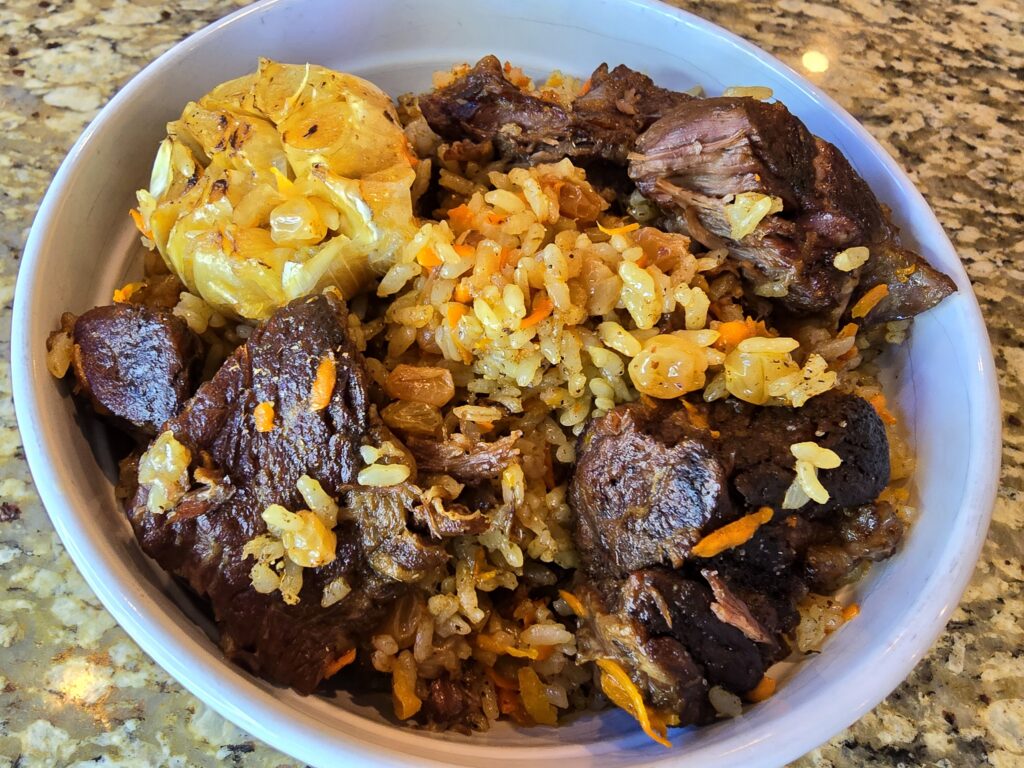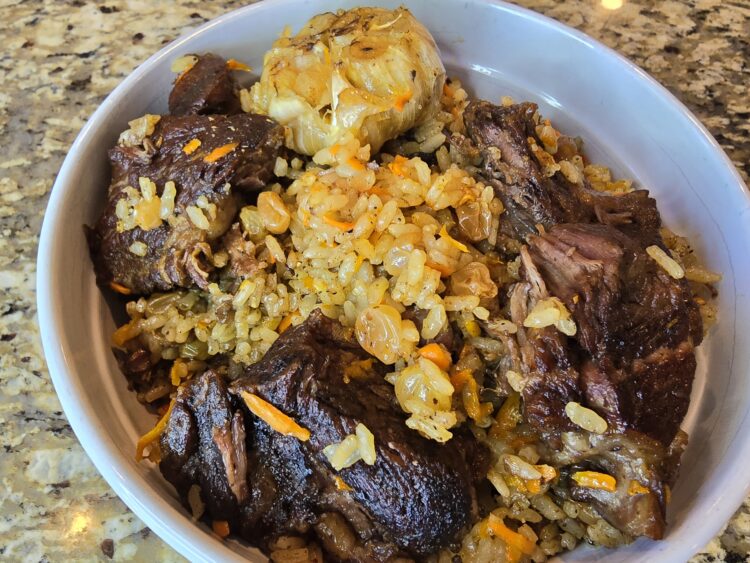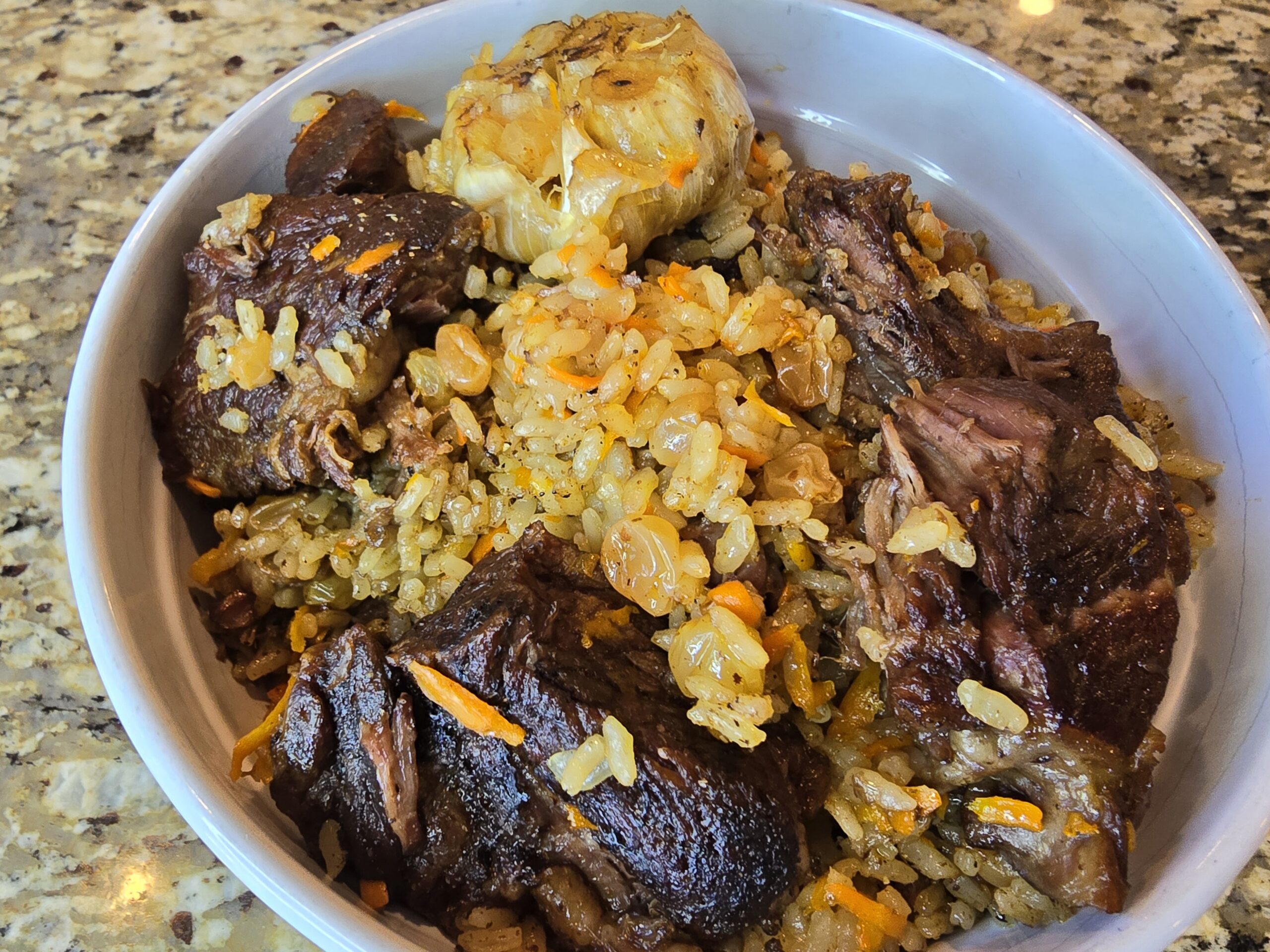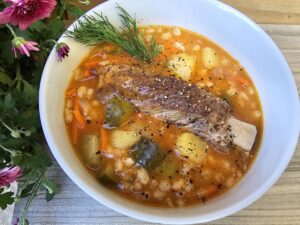If you’re craving a dish that’s bursting with flavor and has the comforting satisfaction of a warm, hearty meal, then this Mediterranean Beef Pilaf, also known as Plov, is for you! This traditional dish has roots in Central Asian and Middle Eastern cuisine and is extremely popular in Russia and across many former Soviet states. With its tender, spiced beef, fragrant rice, and sweet additions like golden raisins, this one-pot meal is an irresistible fusion of flavors and textures that feels both familiar and exotic. 🍲🍇
What is Plov? 🧭
Plov is the Russian and Central Asian version of pilaf—a rice dish traditionally made with meat, vegetables, and a blend of warming spices. In Russia, plov is often served as a celebratory dish at gatherings and festive occasions, and every family has their own take on it. The beauty of plov lies in its versatility; it can be customized with various ingredients to suit personal tastes. Our version brings a Mediterranean twist to this classic, adding golden raisins for a touch of sweetness that complements the rich, savory flavors of the beef.
Why This Version Stands Out 🌟
While many traditional plov recipes are savory and straightforward, this Mediterranean-inspired version layers in even more complexity and depth. Juicy beef, a delicate blend of spices like cumin and coriander, and the addition of golden raisins add a subtle sweetness that pairs beautifully with the aromatic spices. The result is a rich, savory, and slightly sweet pilaf that’s as beautiful as it is delicious.
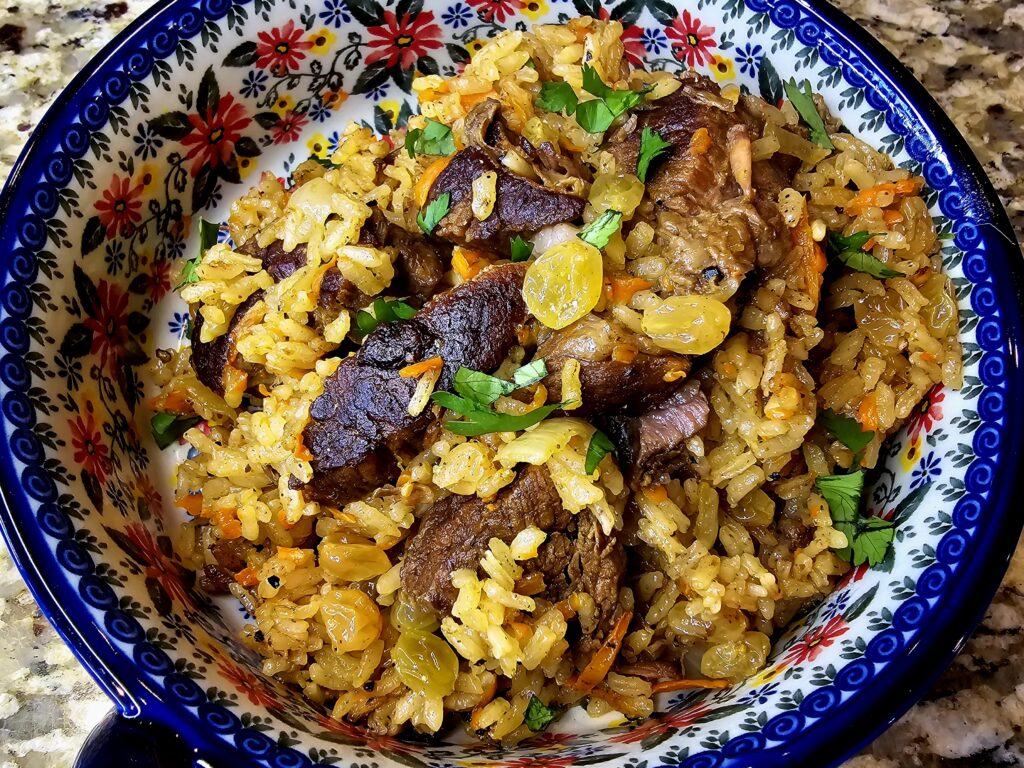
The Science Behind the Perfect Pilaf 🔬🍚
The key to a perfect pilaf lies in cooking the rice to the right texture and ensuring that each grain is infused with the flavors of the dish. Here’s a breakdown of the process:
- Browning the Beef for Umami Depth: Searing the beef at the start of the cooking process develops a rich, deep flavor through the Maillard reaction. This chemical reaction occurs when the natural sugars and amino acids in the meat are exposed to high heat, creating complex flavor compounds and a beautiful golden crust.
- Blooming the Spices: Before adding the rice, the spices (like cumin, coriander, and bay leaves) are gently toasted in the oil to release their essential oils and intensify their flavors. This step ensures that every bite of the pilaf is warm and aromatic.
- Absorption Cooking Method: Similar to risotto, the rice in plov is cooked using the absorption method, where the grains soak up all the liquid from the pot, resulting in rice that’s flavorful and fluffy—not sticky. It’s essential to use just the right amount of liquid to allow the rice to steam evenly without becoming mushy.
- Golden Raisins for Sweetness: Our twist on the classic plov includes adding golden raisins, which bring a subtle burst of sweetness that perfectly balances the savory beef and spices. The raisins plump up during cooking, releasing their natural sugars and adding a hint of sweetness to every bite.
Ingredients You’ll Need 📝
- Beef: Use stew beef or any cut with good marbling, like chuck roast. The fat will melt into the dish, adding richness to the pilaf.
- Rice: Long-grain or basmati rice is best for pilaf, as it stays fluffy and doesn’t clump together.
- Spices: Coriander and bay leaves give this dish its warm, earthy aroma.
- Vegetables: Onion, garlic, and carrots form the base of the dish, adding sweetness and depth.
- Golden Raisins: For a touch of natural sweetness and added texture.
- Liquid: Beef broth or water helps cook the rice and infuses it with flavor.
- Fresh Herbs such as Parsley: For a fresh finish that balances the richness of the beef.
How to Serve Mediterranean Beef Pilaf 🍽️
This dish is delicious on its own, but you can serve it alongside a few Mediterranean-inspired sides to complete the meal:
- Tzatziki Sauce: The cool, creamy yogurt dip complements the warm spices in the pilaf and adds a refreshing contrast.
- Fresh Tomato and Cucumber Salad: A crisp, simple salad with lemon vinaigrette cuts through the richness of the beef and adds a burst of freshness.
- Grilled Flatbread: Perfect for scooping up the pilaf or wrapping around the beef for a fun, handheld bite.
Final Tips for the Best Mediterranean Beef Pilaf 🌟
- Rinse the Rice: Rinse the rice thoroughly until the water runs clear. This step removes excess starch and ensures that the rice cooks up fluffy rather than sticky.
- Simmer Gently: After bringing the liquid to a boil, reduce the heat to low and let the rice steam gently. Avoid stirring once you’ve covered the pot to prevent the rice from becoming mushy.
- Rest Before Serving: Let the pilaf sit off the heat, covered, for about 10 minutes before fluffing it with a fork. This resting period allows the flavors to meld and the rice to set.
Ready to Dig In? 🍽️💛
This Mediterranean Beef Pilaf (Plov) is a showstopper of a dish that’s easy enough for a weeknight but impressive enough for company. It’s flavorful, comforting, and packed with all the vibrant tastes of the Mediterranean with a nod to its Russian roots. Whether you’re new to making pilaf or it’s a beloved family favorite, this recipe will be a delicious addition to your table. Enjoy! 🥂🍚
Beef Plov
Ingredients
1 TBSP olive oil
salt and pepper to taste
3 lbs beef chuck, ideally in steaks or whole roast form
1 onion, halved
5 garlic cloves
1 1/2 cup chicken stock, and possibly more
1 TBSP Sambal Oelek (or more to taste)
2 tsp soy sauce
2 bay leaves
- For the pilaf:
2 TBSP olive oil
1 onion, diced
3 medium carrots, peeled and grated
1 TBSP ground coriander
1 tsp ancho chile powder (and more to taste)
2 cups rice
3 cups chicken stock (less or more depending on the package instructions)
1 cup yellow raisins
3 heads of garlic, with the top 1/4 inch cut exposing the cloves
Directions
- Preheat the oven to 300F. If you have steaks, dry them with paper towels and season very liberally with salt and pepper. If you have a roast, slice it into 1.5 inch steaks, then dry and season them. Preheat oil in a large Dutch oven. This step will likely need to be done in 2 batches (so that you don’t overcrowd the pan – if it’s overcrowded it will steam the steaks instead of searing them.) Search each steak for about 5 minutes per side on high heat until nice golden brown. Remote to a plate.
- Reduce heat to medium and add the onion halves and garlic cloves. Cook for a few minutes until browned and fragrant. Add about 1.5 cup of stock and bring to simmer. Add bay leaves, soy sauce and Sambal Oelek.
- Slice your steaks into thick 2 inch chunks. Don’t be tempted to slice them smaller than that – or your meat will be overcooked and not as tender. Transfer the steaks to the Dutch oven. The stock should almost cover the beef, but not all the way – we are braising, not boiling the meat. If needed, add a bit more stock.
- Bring your stew to a gentle simmer and transfer the whole pot to the preheated oven. Leave the lid slightly ajar (will help thicken your sauce.) Bake in preheated oven for 2 – 2.5 hours. I would go ahead and check after 2 hours and if it’s fall apart tender, your meat is done. If not, it can used up to another half an hour of stewing.
- Remove the pot from the oven. Discard the onion and bay leaves. Remove the meat to a plate. Remove the liquid to a separate bowl.
- To make the pilaf:
- Heat olive oil in a large skillet. Add onions, carrots, coriander and ancho chile powder and cook for about 4-5 minutes until browned; at the same time add the garlic cut side down and allow it to cook for about 3 minutes undisturbed. Add the rice and cook for about two minutes until fragrant. Add enough stock as per the package on the rice package (it's often double the liquid compared to rice, but not always. Calrose rice I like usually calls for much less liquid than that, so check your rice package.) This stock should also include the remaining liquid from braising meat (that we reserved in step 5.) Bring to simmer.
- Layer meat on top. Cover, reduce the heat to maintain gentle simmer and cook for about 20 minutes as per the rice package instructions. Once done, remove from heat and let sit for another 10 minutes.
- In the mean time, boil water and pour over the raisins (that are in a small heat proof bowl.) Let the raisins sit for 5-10 minutes in hot water to hydrate, then drain them.
- When rice is cooked, tender but still maintains it's shape - your dish is done. Stir in the drained raisins. Season with more salt, pepper and/or coriander to taste. Serve and enjoy!
